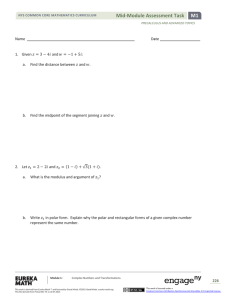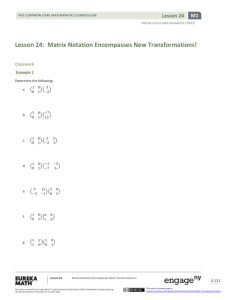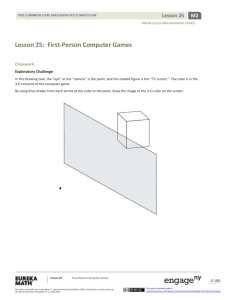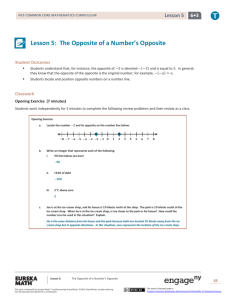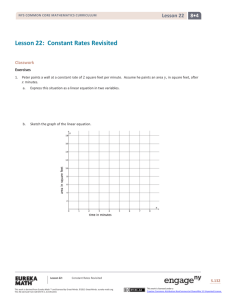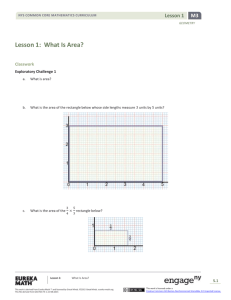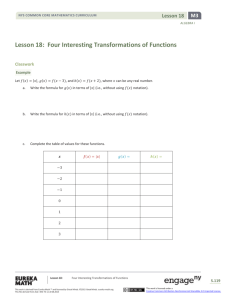Precalculus and Advanced Topics Module 1: Mid
advertisement
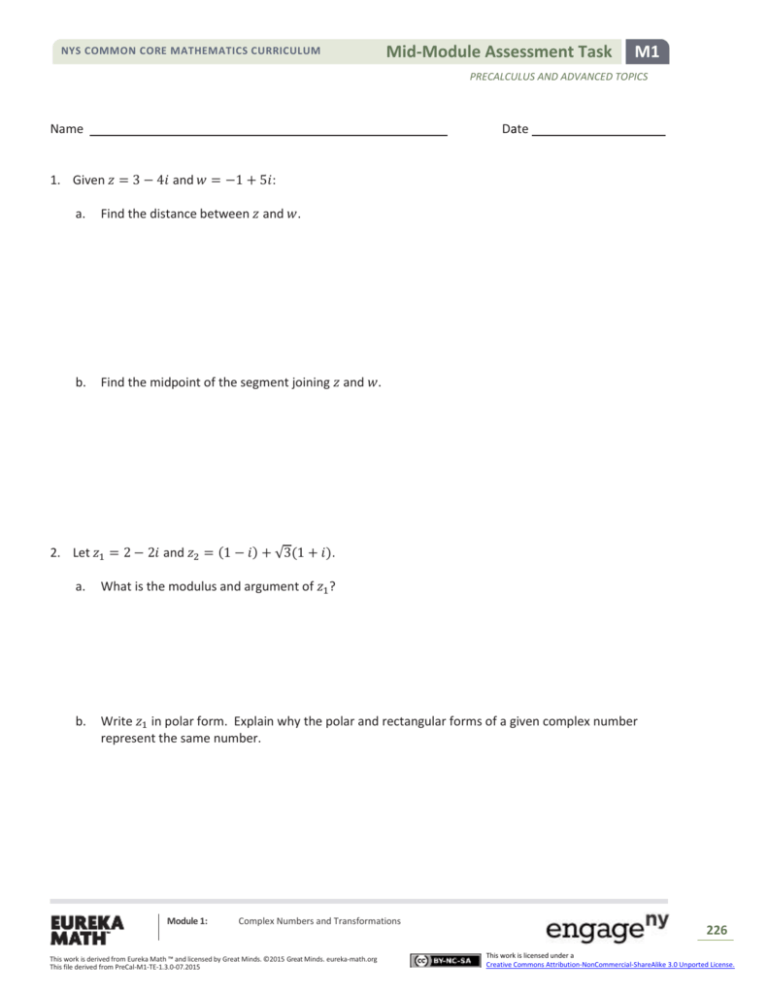
NYS COMMON CORE MATHEMATICS CURRICULUM Mid-Module Assessment Task M1 PRECALCULUS AND ADVANCED TOPICS Name Date 1. Given 𝑧 = 3 − 4𝑖 and 𝑤 = −1 + 5𝑖: a. Find the distance between 𝑧 and 𝑤. b. Find the midpoint of the segment joining 𝑧 and 𝑤. 2. Let 𝑧1 = 2 − 2𝑖 and 𝑧2 = (1 − 𝑖) + √3(1 + 𝑖). a. What is the modulus and argument of 𝑧1 ? b. Write 𝑧1 in polar form. Explain why the polar and rectangular forms of a given complex number represent the same number. Module 1: Complex Numbers and Transformations This work is derived from Eureka Math ™ and licensed by Great Minds. ©2015 Great Minds. eureka-math.org This file derived from PreCal-M1-TE-1.3.0-07.2015 226 This work is licensed under a Creative Commons Attribution-NonCommercial-ShareAlike 3.0 Unported License. NYS COMMON CORE MATHEMATICS CURRICULUM Mid-Module Assessment Task M1 PRECALCULUS AND ADVANCED TOPICS c. Find a complex number 𝑤, written in the form 𝑤 = 𝑎 + 𝑖𝑏, such that 𝑤𝑧1 = 𝑧2 . d. What is the modulus and argument of 𝑤? e. Write 𝑤 in polar form. f. When the points 𝑧1 and 𝑧2 are plotted in the complex plane, explain why the angle between 𝑧1 and 𝑧2 measures arg(𝑤). Module 1: Complex Numbers and Transformations This work is derived from Eureka Math ™ and licensed by Great Minds. ©2015 Great Minds. eureka-math.org This file derived from PreCal-M1-TE-1.3.0-07.2015 227 This work is licensed under a Creative Commons Attribution-NonCommercial-ShareAlike 3.0 Unported License. NYS COMMON CORE MATHEMATICS CURRICULUM Mid-Module Assessment Task M1 PRECALCULUS AND ADVANCED TOPICS g. What type of triangle is formed by the origin and the two points represented by the complex numbers 𝑧1 and 𝑧2 ? Explain how you know. h. Find the complex number, 𝑣, closest to the origin that lies on the line segment connecting 𝑧1 and 𝑧2 . Write 𝑣 in rectangular form. Module 1: Complex Numbers and Transformations This work is derived from Eureka Math ™ and licensed by Great Minds. ©2015 Great Minds. eureka-math.org This file derived from PreCal-M1-TE-1.3.0-07.2015 228 This work is licensed under a Creative Commons Attribution-NonCommercial-ShareAlike 3.0 Unported License. Mid-Module Assessment Task NYS COMMON CORE MATHEMATICS CURRICULUM M1 PRECALCULUS AND ADVANCED TOPICS 3. Let 𝑧 be the complex number 2 + 3𝑖 lying in the complex plane. a. What is the conjugate of 𝑧? Explain how it is related geometrically to 𝑧. b. Write down the complex number that is the reflection of 𝑧 across the vertical axis. Explain how you determined your answer. 1 Let 𝑚 be the line through the origin of slope in the complex plane. 2 c. Write down a complex number, 𝑤, of modulus 1 that lies on 𝑚 in the first quadrant in rectangular form. Module 1: Complex Numbers and Transformations This work is derived from Eureka Math ™ and licensed by Great Minds. ©2015 Great Minds. eureka-math.org This file derived from PreCal-M1-TE-1.3.0-07.2015 229 This work is licensed under a Creative Commons Attribution-NonCommercial-ShareAlike 3.0 Unported License. Mid-Module Assessment Task NYS COMMON CORE MATHEMATICS CURRICULUM M1 PRECALCULUS AND ADVANCED TOPICS d. What is the modulus of 𝑤𝑧? e. Explain the relationship between 𝑤𝑧 and 𝑧. First, use the properties of modulus to answer this question, and then give an explanation involving transformations. f. When asked, “What is the argument of 1 𝑤 𝑧?” 3 1 Paul gave the answer arctan (2) − arctan (2), which he then computed to two decimal places. Provide a geometric explanation that yields Paul’s answer. Module 1: Complex Numbers and Transformations This work is derived from Eureka Math ™ and licensed by Great Minds. ©2015 Great Minds. eureka-math.org This file derived from PreCal-M1-TE-1.3.0-07.2015 230 This work is licensed under a Creative Commons Attribution-NonCommercial-ShareAlike 3.0 Unported License. Mid-Module Assessment Task NYS COMMON CORE MATHEMATICS CURRICULUM M1 PRECALCULUS AND ADVANCED TOPICS g. When asked, “What is the argument of 1 𝑤 𝑧?” Mable did the complex number arithmetic and computed 𝑧 ÷ 𝑤. 𝑎 𝑏 𝑎 She then gave an answer in the form arctan ( ) for some fraction . What fraction did Mable find? 𝑏 Up to two decimal places, is Mable’s final answer the same as Paul’s? Module 1: Complex Numbers and Transformations This work is derived from Eureka Math ™ and licensed by Great Minds. ©2015 Great Minds. eureka-math.org This file derived from PreCal-M1-TE-1.3.0-07.2015 231 This work is licensed under a Creative Commons Attribution-NonCommercial-ShareAlike 3.0 Unported License. NYS COMMON CORE MATHEMATICS CURRICULUM Mid-Module Assessment Task M1 PRECALCULUS AND ADVANCED TOPICS A Progression Toward Mastery Assessment Task Item 1 a N-CN.B.6 b N-CN.B.6 2 a N-CN.B.4 b STEP 1 Missing or incorrect answer and little evidence of reasoning or application of mathematics to solve the problem. STEP 2 Missing or incorrect answer but evidence of some reasoning or application of mathematics to solve the problem. STEP 3 A correct answer with some evidence of reasoning or application of mathematics to solve the problem, OR an incorrect answer with substantial evidence of solid reasoning or application of mathematics to solve the problem. STEP 4 A correct answer supported by substantial evidence of solid reasoning or application of mathematics to solve the problem. Student provides an incorrect response, and there is no evidence to support that student understands how to compute the distance. Student shows some knowledge of the distance formula but does not use the formula correctly. Student uses the formula correctly but makes minor mathematical mistakes. OR Student computes distance correctly with no supporting work. Student computes the distance correctly with supporting work shown. Student provides an incorrect response, and there is no evidence to support that student understands how to compute the midpoint. Student shows some knowledge of the midpoint formula but does not use the formula correctly. Student uses the formula correctly but makes minor mathematical mistakes. OR Student computes the midpoint correctly with no supporting work. Student computes the midpoint correctly with supporting work shown. Student provides an incorrect response, and there is no evidence to support that student understands how to compute the modulus and argument. Student uses the correct method and answer for either the modulus or the argument. OR Student uses the correct method for both but makes minor errors. Student uses the correct methods for both, but either the modulus or argument is incorrect due to a minor error. OR Student gives correct answers for both with no supporting work shown. Student computes modulus and argument correctly. Work is shown to support the answer. Student shows no knowledge of polar form. Student attempts to put the complex number into polar form but makes errors. Student writes the correct polar form but does not explain why polar and rectangular forms represent the same number. Student writes the correct polar form and correctly explains why polar and rectangular forms represent the same number. N-CN.B.4 Module 1: Complex Numbers and Transformations This work is derived from Eureka Math ™ and licensed by Great Minds. ©2015 Great Minds. eureka-math.org This file derived from PreCal-M1-TE-1.3.0-07.2015 232 This work is licensed under a Creative Commons Attribution-NonCommercial-ShareAlike 3.0 Unported License. NYS COMMON CORE MATHEMATICS CURRICULUM Mid-Module Assessment Task M1 PRECALCULUS AND ADVANCED TOPICS Student does not attempt to divide 𝑧2 by 𝑧1 to find 𝑤. Student attempts to divide 𝑧2 by 𝑧1 without applying the correct algorithm involving multiplication by 1 in the form of the conjugate 𝑧1 divided by the conjugate of 𝑧1 . Student applies the division algorithm correctly and shows work but has minor mathematical errors leading to an incorrect final answer. Student applies the division algorithm correctly and gives a correct answer with sufficient work shown to demonstrate understanding of the process. N-CN.B.5 N-CN.B.6 Student does not compute either answer correctly, nor is there evidence to support that student understands how to compute the modulus and argument. Student computes the modulus or argument correctly. OR Student uses correct methods for both but arrives at incorrect answers due to minor errors. Student uses correct methods for both, but either the modulus or the argument is incorrect due to a minor error. OR Student gives correct answers for both with no supporting work shown. Student computes modulus and argument correctly for the answer to part (b), and work is shown to support answer. Note: Student can earn full points for this even if the answer to part (b) is incorrect. e Student shows no knowledge of polar form. Student shows some knowledge of polar form but does make major mathematical errors. Student shows knowledge of polar form but makes minor mathematical errors. Student writes the correct polar form of the number. Student makes little or no attempt to identify the angle measure. Student cannot determine the angle between the two complex numbers whose vertex is at the origin. Student provides an explanation that fails to connect multiplication with transformations. The explanation may include a comparison of the moduli of 𝑧1 and 𝑧2 . The answer may include a sketch to support the answer. Student may not indicate the requested angle measurement or gives an incorrect angle measurement. Student provides an explanation that does not fully address the connection between multiplication and transformations but may include a comparison of the moduli of 𝑧1 and 𝑧2 . The answer may be supported with a sketch. Student explanation clearly connects multiplication with the correct transformations by explaining that 𝑧2 is the image of 𝑧1 achieved by rotating 𝑧1 by the arg(𝑤) and no dilation since |𝑤| = 1. The answer may be supported with a sketch. Student makes little or no attempt to identify the triangle. Student may identify the triangle as isosceles but with little or no explanation. Student identifies the triangle as isosceles or equilateral but gives an incomplete or incorrect explanation. Student identifies the triangle as equilateral and gives a complete explanation. c N-CN.A.3 d N-CN.B.4 f N-CN.B.4 N-CN.B.5 g N-CN.B.4 N-CN.B.5 Module 1: Complex Numbers and Transformations This work is derived from Eureka Math ™ and licensed by Great Minds. ©2015 Great Minds. eureka-math.org This file derived from PreCal-M1-TE-1.3.0-07.2015 233 This work is licensed under a Creative Commons Attribution-NonCommercial-ShareAlike 3.0 Unported License. NYS COMMON CORE MATHEMATICS CURRICULUM Mid-Module Assessment Task M1 PRECALCULUS AND ADVANCED TOPICS h Student makes little or no attempt to find 𝑣. Student may attempt to sketch the situation, but more than one misconception or mathematical error leads to an incorrect or incomplete solution. Student finds 𝑣 correctly, but there is little or no explanation or work explaining why 𝑣 is the midpoint of the line segment. OR Student identifies that 𝑣 would be at the midpoint but fails to compute it correctly. Student averages 𝑧1 and 𝑧2 to find 𝑣 and clearly explains why using a geometric argument regarding 𝑣’s location on the perpendicular bisector of the triangle. Student incorrectly answers both the real and the imaginary part. Student incorrectly answers either the real or the imaginary part. Student gives the correct answer but does not give an explanation. Student gives the correct answer and includes the correct explanation of how it is geometrically related to 𝑧. Student incorrectly answers both the real and the imaginary part. Student incorrectly answers either the real or the imaginary part. Student gives the correct answer but does not give an explanation. Student gives the correct answer and explains that the real part is the opposite but that the imaginary part stays the same. Student provides an answer that is not a complex number. OR Student provides an answer that is a complex number with both an incorrect modulus and argument. There is little or no supporting work shown. Student gives an incorrect answer with little evidence of correct reasoning (solution may fail to address modulus of 1 but be a complex number on the line 𝑚 or may have a modulus of 1 but not be a complex number on the line 𝑚). Student gives the correct answer with limited reasoning or work to support the answer. OR Student uses correct reasoning, but minor mathematical errors lead to an incorrect solution. Student gives a correct answer with work shown to support approach. Student reasoning could use the polar form of a complex number or apply proportional reasoning to find 𝑤 with the correct argument and modulus. Student shows no knowledge of 𝑤𝑧 or the modulus. Student shows some knowledge of calculating the modulus, but the answer is incorrect with little supporting work shown. Student makes minor mathematical errors in calculating the modulus. Student gives a correct answer with supporting work shown clearly. Student does not explain the relationship between 𝑧 and 𝑤𝑧. Student gives minimal explanation with some mistakes. Student explains connection but does not include transformations that occur. Student gives clear and correct explanation that includes transformations that occur. N-CN.B.4 N-CN.B.6 3 a N-CN.A.3 N-CN.B.5 b N-CN.A.3 N-CN.B.5 c N-CN.B.4 d N-CN.B.4 e N-CN.B.4 Module 1: Complex Numbers and Transformations This work is derived from Eureka Math ™ and licensed by Great Minds. ©2015 Great Minds. eureka-math.org This file derived from PreCal-M1-TE-1.3.0-07.2015 234 This work is licensed under a Creative Commons Attribution-NonCommercial-ShareAlike 3.0 Unported License. Mid-Module Assessment Task NYS COMMON CORE MATHEMATICS CURRICULUM M1 PRECALCULUS AND ADVANCED TOPICS f N-CN.B.5 N-CN.B.6 Student shows little or no work. The explanation fails to address transformations in a meaningful way. Student provides an explanation that may include references to rotations and dilations but does not clearly address the fact that multiplication by 1 𝑤 represents a clockwise rotation of arg(𝑤). g N-CN.A.3 N-CN.B.5 Student answers both 𝑧 𝑤 𝑧 𝑤 and arg ( ) incorrectly due to major misconceptions or calculation errors. Student may argue incorrectly that the arguments in parts (e) and (f) should be different. Module 1: Student answers either 𝑧 𝑤 𝑧 𝑤 or arg ( ) incorrectly due to mathematical errors. Student indicates that both arguments should be the same. Complex Numbers and Transformations This work is derived from Eureka Math ™ and licensed by Great Minds. ©2015 Great Minds. eureka-math.org This file derived from PreCal-M1-TE-1.3.0-07.2015 Student identifies arg(𝑧) and arg(𝑤) and explains that multiplication by 1 𝑤 would create a clockwise rotation, but the explanation lacks a clear reason why the two should be subtracted or contains other minor errors. Student correctly computes 𝑧 𝑤 𝑧 𝑤 and arg ( ) but fails to compare the arguments in parts (d) and (e) or explain why they should be the same. Student explains both the rotation and lack of dilation correctly since |𝑤| = 1. In the explanation, student identifies arg(𝑧) and arg(𝑤) and supports the reason for the difference. A sketch may be included. Student correctly computes both arguments to two decimal places. Work shown uses appropriate notation and sufficient steps to follow the solution. 235 This work is licensed under a Creative Commons Attribution-NonCommercial-ShareAlike 3.0 Unported License. Mid-Module Assessment Task NYS COMMON CORE MATHEMATICS CURRICULUM M1 PRECALCULUS AND ADVANCED TOPICS Name Date 1. Given 𝑧 = 3 − 4𝑖 and 𝑤 = −1 + 5𝑖: a. Find the distance between 𝑧 and 𝑤. 2 Distance = √(3 − (−1)) − ( − 1) + ((− 4) − 5) 2 2 = √42 + ( − 9) = √16 + 81 = √97 b. Find the midpoint of the segment joining 𝑧 and 𝑤. 3 + (−1) (−4) + 5 + i 2 2 2 1 = + i 2 2 1 = 1+ i 2 Midpoint = 2. Let 𝑧1 = 2 − 2𝑖 and 𝑧2 = (1 − 𝑖) + √3(1 + 𝑖). a. What is the modulus and argument of 𝑧1 ? |z1 | = √(2)2 + (- 2)2 = √8 = 2√2 −2 −π arg(z1 ) = tan−1 ( )= 2 4 b. Write 𝑧1 in polar form. Explain why the polar and rectangular forms of a given complex number represent the same number. z1 = 2√2 [cos ( −π −π ) + i sin ( )] 4 4 The modulus represents the distance from the origin to the point. The degree of rotation is the angle from the x-axis. When the polar form is expanded, the result is the rectangular form of a complex number. Module 1: Complex Numbers and Transformations This work is derived from Eureka Math ™ and licensed by Great Minds. ©2015 Great Minds. eureka-math.org This file derived from PreCal-M1-TE-1.3.0-07.2015 236 This work is licensed under a Creative Commons Attribution-NonCommercial-ShareAlike 3.0 Unported License. NYS COMMON CORE MATHEMATICS CURRICULUM Mid-Module Assessment Task M1 PRECALCULUS AND ADVANCED TOPICS c. Find a complex number 𝑤, written in the form 𝑤 = 𝑎 + 𝑖𝑏, such that 𝑤𝑧1 = 𝑧2 . z2 = 1 − i + √3 + i √3 = (√3 + 1) + (√3 − 1)i w z1 = w2 implies that w= d. z2 [(√3 + 1) + (√3 − 1)i] (2 + 2i) = × (2 − 2i) (2 + 2i) z1 = 2√3 + 2 + 2i√3 + 2i + 2i√3 − 2i − 2√3 + 2 4+4 = 4 + 4i√3 8 = 1 √3 + i. 2 2 What is the modulus and argument of 𝑤? 2 1 2 1 3 √3 |w| = √( ) + ( ) = √ + = 1 2 2 4 4 arg(w) = tan e. -1 √3 π ( 2 )= 1 3 2 Write 𝑤 in polar form. π π w = 1 [cos ( ) + i sin ( )] 3 3 f. When the points 𝑧1 and 𝑧2 are plotted in the complex plane, explain why the angle between 𝑧1 and 𝑧2 measures arg(𝑤). Since z2 = w z1 , then z2 is the transformation of z1 rotated counterclockwise by arg(w), which is π 3 . Module 1: Complex Numbers and Transformations This work is derived from Eureka Math ™ and licensed by Great Minds. ©2015 Great Minds. eureka-math.org This file derived from PreCal-M1-TE-1.3.0-07.2015 237 This work is licensed under a Creative Commons Attribution-NonCommercial-ShareAlike 3.0 Unported License. NYS COMMON CORE MATHEMATICS CURRICULUM Mid-Module Assessment Task M1 PRECALCULUS AND ADVANCED TOPICS g. What type of triangle is formed by the origin and the two points represented by the complex numbers 𝑧1 and 𝑧2 ? Explain how you know. Since |w| = 1 and arg(w) = π , the triangle formed by the origin and the points 3 representing z1 and z2 will be equilateral. All of the angles are 60° in this triangle. h. Find the complex number, 𝑣, closest to the origin that lies on the line segment connecting 𝑧1 and 𝑧2 . Write 𝑣 in rectangular form. The point that represents v is the midpoint of the segment connecting z1 and z2 since it must be on the perpendicular bisector of the triangle with vertex at the origin. To find the midpoint, average z1 and z2 . v= Module 1: √3 + 1 + 2 √3 − 1 − 2 √3 + 3 √3 − 3 + i = + i 2 2 2 2 Complex Numbers and Transformations This work is derived from Eureka Math ™ and licensed by Great Minds. ©2015 Great Minds. eureka-math.org This file derived from PreCal-M1-TE-1.3.0-07.2015 238 This work is licensed under a Creative Commons Attribution-NonCommercial-ShareAlike 3.0 Unported License. Mid-Module Assessment Task NYS COMMON CORE MATHEMATICS CURRICULUM M1 PRECALCULUS AND ADVANCED TOPICS 3. Let 𝑧 be the complex number 2 + 3𝑖 lying in the complex plane. a. What is the conjugate of 𝑧? Explain how it is related geometrically to 𝑧. z̅ = 2 − 3i This number is the conjugate of z and the reflection of z across the horizontal axis. b. Write down the complex number that is the reflection of 𝑧 across the vertical axis. Explain how you determined your answer. This number is −2 + 3i. The real coordinate has the opposite sign, but the imaginary part keeps the same sign. This means a reflection across the imaginary (vertical) axis. 1 Let 𝑚 be the line through the origin of slope in the complex plane. 2 c. Write down a complex number, 𝑤, of modulus 1 that lies on 𝑚 in the first quadrant in rectangular form. Because the slope of m is 1 2 1 2 , the argument of w is tan-1 ( ). Using the polar form of w, 1 2 1 2 w = 1 [cos (tan-1 ( )) + i sin (tan-1 ( ))]. From the triangle shown below, w = Module 1: 2 √5 + 1 √5 i. Complex Numbers and Transformations This work is derived from Eureka Math ™ and licensed by Great Minds. ©2015 Great Minds. eureka-math.org This file derived from PreCal-M1-TE-1.3.0-07.2015 239 This work is licensed under a Creative Commons Attribution-NonCommercial-ShareAlike 3.0 Unported License. Mid-Module Assessment Task NYS COMMON CORE MATHEMATICS CURRICULUM M1 PRECALCULUS AND ADVANCED TOPICS d. What is the modulus of 𝑤𝑧? The modulus of w z is √13. e. Explain the relationship between 𝑤𝑧 and 𝑧. First, use the properties of modulus to answer this question, and then give an explanation involving transformations. The modulus of w z is √13 and is the same as |z|. Using the properties of modulus, |wz| = |w| × |z| = 1 × |z| = 1 × √22 + 32 = √13. Geometrically, multiplying by w will rotate z by the arg(w) and dilate z by |w|. Since |w| = 1, the transformation is a rotation only, so both w and z are the same distance from the origin. f. When asked, “What is the argument of 1 𝑤 𝑧?” 3 1 Paul gave the answer arctan ( ) − arctan ( ), which he then computed to two decimal places. 2 2 Provide a geometric explanation that yields Paul’s answer. The product 1 w z would result in a clockwise rotation of z by the arg(w). There would be no dilation since |w| = 1. 3 arg(z) = tan-1 ( ) 2 1 arg(w) = tan-1 ( ) 2 1 3 1 arg ( z) = tan-1 ( ) − tan-1 ( ) w 2 2 Module 1: Complex Numbers and Transformations This work is derived from Eureka Math ™ and licensed by Great Minds. ©2015 Great Minds. eureka-math.org This file derived from PreCal-M1-TE-1.3.0-07.2015 240 This work is licensed under a Creative Commons Attribution-NonCommercial-ShareAlike 3.0 Unported License. Mid-Module Assessment Task NYS COMMON CORE MATHEMATICS CURRICULUM M1 PRECALCULUS AND ADVANCED TOPICS g. When asked, “What is the argument of 1 𝑤 𝑧?” Mable did the complex number arithmetic and computed 𝑧 ÷ 𝑤. She then gave an answer in the 𝑎 𝑎 form arctan (𝑏) for some fraction . What fraction did Mable find? Up to two decimal places, is 𝑏 Mable’s final answer the same as Paul’s? ̅ ̅ z zw zw = = = ̅ |w| w ww = = 2 1 (2 + 3i) × ( − i) √5 √5 1 4 √5 7 √5 + + 6i √5 4 √5 − 2i √5 + 3 √5 i Comparing these angles shows they are the same. 4 tan-1 ( ) ≈ 0.52 7 3 1 tan-1 ( ) - tan-1 ( ) ≈ 0.52 2 2 Module 1: Complex Numbers and Transformations This work is derived from Eureka Math ™ and licensed by Great Minds. ©2015 Great Minds. eureka-math.org This file derived from PreCal-M1-TE-1.3.0-07.2015 241 This work is licensed under a Creative Commons Attribution-NonCommercial-ShareAlike 3.0 Unported License.

